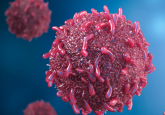Lapatinib–trastuzumab combination shows ‘ground-breaking potential’ in HER2 breast cancer trial

A combination of lapatinib and trastuzumab has been demonstrated to shrink tumors in approximately a quarter of HER2-positive breast cancer patients in a recent clinical trial. Details of the trial, the results of which are described as having ‘ground-breaking potential’, were presented recently at the 10th European Breast Cancer Conference (9–11 March, Amsterdam, The Netherlands).
Nigel Bundred of the University of Manchester presented the results, stating: “This has ground-breaking potential because it allows us to identify a group of patients who, within 11 days, have had their tumors disappear with anti-HER2 therapy alone and who potentially may not require subsequent chemotherapy. This offers the opportunity to tailor treatment for each individual woman.”
This trial, termed UK EPHOS-B, involved 257 women with newly diagnosed HER2-positive breast cancer that was deemed operable, and was split into two parts. In the first, a study group of 130 women were randomized to receive no pre-operative treatment, or trastuzumab only, or lapatinib only, for 11 days after diagnosis and prior to surgery.
As part one of the trial progressed, data from other trials emerged indicating the efficacy of lapatinib and trastuzumab in combination for the treatment of HER2-positive breast cancer. Thus, from August 2013 the trial design was adjusted and the next 127 women enrolled were randomized to the control group, or to receive trastuzumab only, or the combination treatment.
Following surgery, all study participants received standard-of-care treatment. Tumor samples were isolated from the first biopsy (used to confirm diagnosis) and again during surgery. Samples were analyzed for reductions in Ki-67 expression and for significant increases in apoptosis (30% or more) over the treatment period.
As well as these analyses, postsurgical pathology reports were utilized to categorize the women as having pathological complete response (pCR), minimal residual disease (MRD; tumor < 5 mm in diameter), or other.
Of the individuals treated with the lapatinib and trastuzumab combination, 11% had pCR and 17% had MRD – including responses in women with stage II disease. By contrast, the women randomized to receive trastuzumab alone demonstrated 0% pCR and 3% MRD.
Lead researcher, Judith Bliss from The Institute of Cancer Research (London, UK), commented: “These results show that we can get an early indication of pathological response within 11 days, in the absence of chemotherapy, in these patients on combination treatment. Most previous trials have only looked at the pathological response after several months of treatment. Clearly these results need further confirmation, but I suspect the excitement from seeing the speed of disappearance of the tumors will mean that several trials will attempt to confirm these results.”




